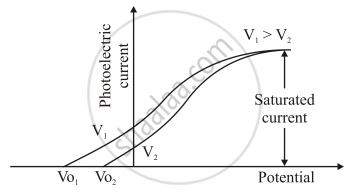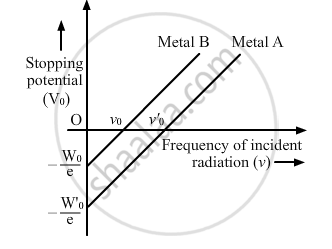Advertisements
Advertisements
प्रश्न
Draw a plot showing the variation of photoelectric current with collector plate potential for two different frequencies, v1 > v2, of incident radiation having the same intensity. In which case will the stopping potential be higher? Justify your answer.
उत्तर
Effect of frequency of the incident radiation:
Taking radiations of different frequencies but of same intensity, the variation between photoelectric current and potential of plate A is obtained and shown in graph given below:

From the graph, we note:
(i) The value of stopping potential is different for radiation of different frequency.
(ii) The value of stopping potential is more negative for radiation of higher incident frequency.
(iii) The value of saturation current depends on the intensity of incident radiation, but is independent of the frequency of the incident radiation.
APPEARS IN
संबंधित प्रश्न
The photoelectric work function for a metal is 4.2 eV. If the stopping potential is 3V, find the threshold wavelength and maximum kinetic energy of emitted electrons.
(Velocity of light in air = 3 x 108m/s,
Planck's constant = 6·63 x10-34 J -s,
Charg.e ori electron = 1·6 x 10 -19 C)
Two monochromatic beams, one red and the other blue, have the same intensity. In which case (i) the number of photons per unit area per second is larger, (ii) the maximum kinetic energy of the photoelectrons is more? Justify your answer.
The graph shows the variation of stopping potential with frequency of incident radiation for two photosensitive metals A and B. Which one of the two has higher value of work-function? Justify your answer.

A photosensitive surface emits photoelectrons when red light falls on it. Will the surface emit photoelectrons when blue light is incident on it? Give reason.
Draw a plot showing the variation of photoelectric current with collector potential for different frequencies but same intensity of incident radiation ?
Use Einstein's photoelectric equation to explain the observations from this graph ?
What is photoelectri effect ? Defin (i) Stopping potential (ii) Photoelectric work function.
With reference to the photoelectric effect, what is meant by threshold wavelength?
State how will you use this graph to detennine the value of Planck's constant.
Consider an electron in front of metallic surface at a distance d (treated as an infinite plane surface). Assume the force of attraction by the plate is given as `1/4 q^2/(4πε_0d^2)`. Calculate work in taking the charge to an infinite distance from the plate. Taking d = 0.1 nm, find the work done in electron volts. [Such a force law is not valid for d < 0.1nm].
